Note: The following is an example of Huawei products. Our company does not sell Huawei products. If necessary, please purchase directly from Huawei. Our company only makes products with similar functions. If you have any needs, please contact our sales team directly.
In ODN, from the business aggregation point to the user, it is generally divided into multiple sections: backbone, wiring, introduction, and home entry. See the article “ODN Optical Distribution Network Structure”.
In the traditional ODN network, should splice a large number of fibers in the introduction section, and both ends of drop cable in households need to be terminated. But optical fiber splicing has high technical requirements for construction and installation and maintenance personnel, and on-site construction operations are also time-consuming. Therefore, pre-connected ODN technology that does not require on-site fiber core welding has emerged.
ODN uses active connections at both the cabinets and fiber distribution box. Since the doors of the cabinet and the fiber distribution box need to be opened and closed frequently during the installation and maintenance process, the installation and maintenance personnel will find it very inconvenient to avoid inadvertently opening and closing the doors, as shown in the figure 1. Due to the influence of the environment for a long time, the optical splitters, pigtails and other components inside the box are easily aged, and the end faces of the connectors are also easily contaminated, causing connection failures.
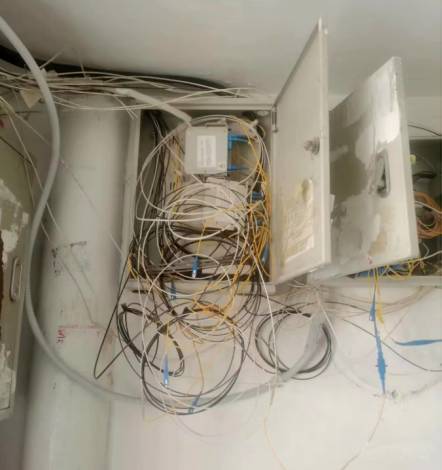
In the construction of the introduction section of traditional ODN, optical fiber splicing is involved in almost every optical cable distribution box, as shown in Figure 2. Optical cable laying, optical fiber splicing, fiber distribution box installation and other work can only be carried out step by step and cannot be constructed in parallel, which also results in a relatively long construction period for introducing optical cables.
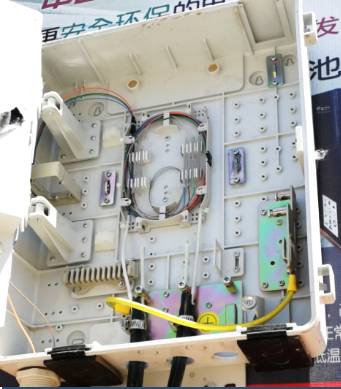
When installing broadband users, since both ends of drop cable need to be spliced with a pigtail for termination, as shown in Figure 3 (the red arrow in the figure points to the splicing point), this also increases the time required to operate.
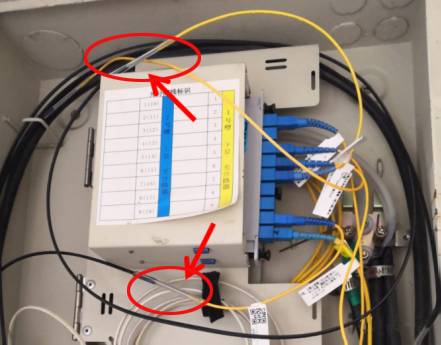
Optical fiber splicing must be equipped with a splice machine, and operators also need certain skills. Therefore, the construction of traditional ODN and the installation and maintenance of broadband users have relatively high technical requirements for relevant personnel.
In order to solve the above problems faced by traditional ODN during construction and maintenance, pre-connected ODN adopts the following technologies.
Pre-connection means that the movable connectors are prefabricated at both ends of the optical cable in the factory to become a prefabricated cable. The movable connectors are also prefabricated at the connection between the wiring equipment (cabinet, fiber distribution box) and the optical cable to become the pre-connected wiring equipment, In this way, during ODN construction and installation and maintenance, the connection of ODN optical fiber links does not require splicing, and can only be completed through active connections.
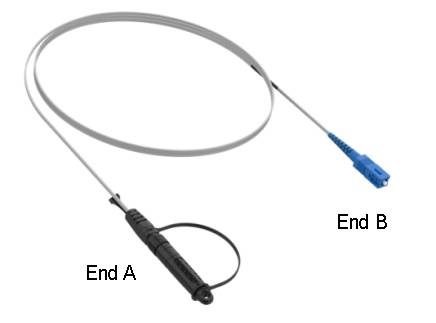
For example, Figure 4 shows the prefabricated cable in the home section. The A-end of the cable is a SC/APC waterproof connector, which can be directly connected to the user port of the pre-connected optical splitter box (equivalent to the output port of the optical splitter in the ordinary fiber splitter box) to make a movable connection, as shown in Figure 5; the B end of the cable is an ordinary SC-type connector, which can be directly connected to the ONT. In this way, when home broadband users install it, the home section optical cable only needs to be assembled on site to complete the connection of the optical cable link, without the need for on-site splicing.

Traditional ODN uses balanced splitting. There are many types of cables in the introduction section, complex fiber core distribution, and a large number of fiber core connections. This situation is not suitable for pre-connection. When ODN uses unequal splitting, the introduction cable can use single-core optical cable. There are few types of cables and the fiber core connection is simple. Therefore, pre-connected ODN usually adopt unequal splitting. The ODN networking model with unbalanced splitting mainly uses single chain and double chain. See article “What is unbalanced splitter, and how to do in ODN networking”. Figure 6 shows the networking model of one branch chain when use double chain. In the optical fiber link from the pre-connected cabinet to the ONT, only single-core prefabricated cables are used.

The box body of the pre-connected cabinet and the box body of the pre-connected optical splitter box adopt a sealed structure to seal the splicing unit and optical splitter in the box/box body to avoid the effects on splitter or fiber from accidentally touching by surrounding environment and personnel. At the same time, the downlink interface of the pre-connected cabinet and the uplink/downlink interface of the pre-connected optical splitter box are set outside the box/box. The interfaces are of a type adapted to the prefabricated cable to facilitate connection with cable. For example, the appearance and interface of the pre-connected cabinet are shown in Figure 7, in which the splicing unit can be opened, it is specially for splicing the cores of ordinary distribution cables.

SC/APC waterproof connectors are used for movable connections used in outdoor, underground and other environments that require waterproofing and dust-proof. The connector is fully sealed before and after connection, avoiding harmful effects such as ultraviolet rays, water vapor, dust, etc.
The factory value of the insertion loss of ordinary single-core connectors generally does not exceed 0.25dB/piece. In traditional communication project, considering the long-term impact of the environment on the connectors, the attenuation standard of ordinary single-core connectors is 0.5dB/piece. Since the active connections of pre-connected ODN adopt fully sealed protection measures, the insertion loss generally does not exceed 0.3dB/piece.
Pre-connected ODN products mainly include pre-connected cabinets, pre-connected optical splitting boxes, prefabricated cables, pre-connected distribution boxes and pre-connected joint closures.
The network position of the pre-connected cabinet in the ODN is equivalent to the distribution cabinet. The length and width are about the same size as a laptop. The splice tray can support up to 48 core connections. There are 4 inlets and outlets for distribution cables and 8 interfaces for single-core prefabricated cable.
Pre-connected splitter box can be cascade type or terminal type. The cascade type has a built-in 1×5 or 1×9 optical splitter, with 1 uplink port, 1 downlink port, and 4 or 8 user ports, as shown in Figure 8. The splitter box ① and ② in Figure 6 are cascade types.
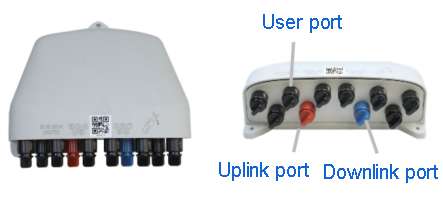
The terminal type has a built-in 1×4 or 1×8 optical splitter, with 1 uplink port and 4 or 8 user ports. Compared with the cascade type, it has one less downlink port, but other aspects are the same. The splitter box ③ in Figure 6 is a terminal type.
Prefabricated cables are mainly divided into introduction type, hybrid type and household type.
The introduction type is mainly used for the connection between the pre-connected cabinet and the fiber distribution box, the fiber distribution box and the fiber distribution box. The cable is round with good mechanical strength. Both ends of the cable are SC/APC waterproof connectors, as shown in Figure 9. The cable length specifications are multiples of 50m. The maximum section length of aerial cables is 500m, and the maximum section length of pipeline cables is 350m.

The hybrid type only has 1 waterproof connector at one end , the other end use ordinary SC connector, the rest are the same as introduction type, as shown in Figure 10. The hybrid type can be used to connect ordinary wiring cabinets (or ordinary fiber distribution boxes) to pre-connected optical distribution boxes.
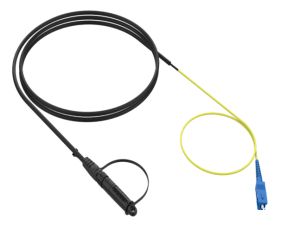
The household type adopt drop cable, as shown in Figure 4. The mechanical properties are average and are mainly used in indoor environments, such as user installations.
In branch routing, ODN adopts a chain networking structure, which will cause detours in the routing of introduction cables. When the route detour length is long (generally greater than 100 meters), it becomes economically unreasonable. At this time, a splitter box can be added to the branch point of the route, as shown in Figure 11.
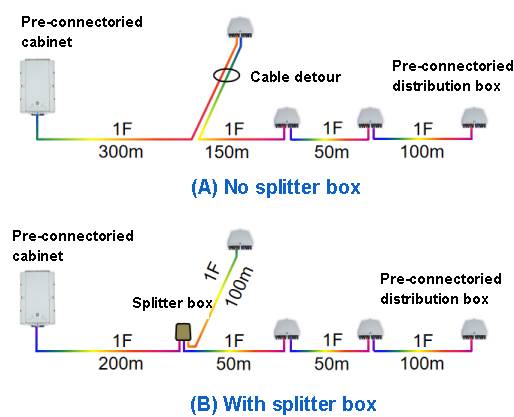
The splitter box has one input port and two output ports, both of which are SC/APC waterproof interfaces, as shown in Figure 12. The splitter box contains a 1×2 unequal ratio optical splitter. The optical power distribution ratio of the splitter’s two output ports is 30/70, and the insertion loss is approximately 6.0dB/2.2dB.
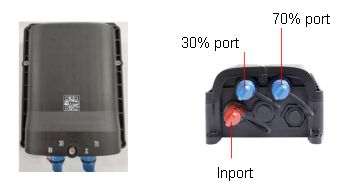
Limited by the maximum segment length of prefabricated cables, when the link length between adjacent pre-connected devices in an ODN link exceeds the maximum segment length, the prefabricated cables need to be connected through pre-connected joint box. There is only one single-core adapter inside the single-core pre-connected splice closure, as shown in Figure 13.
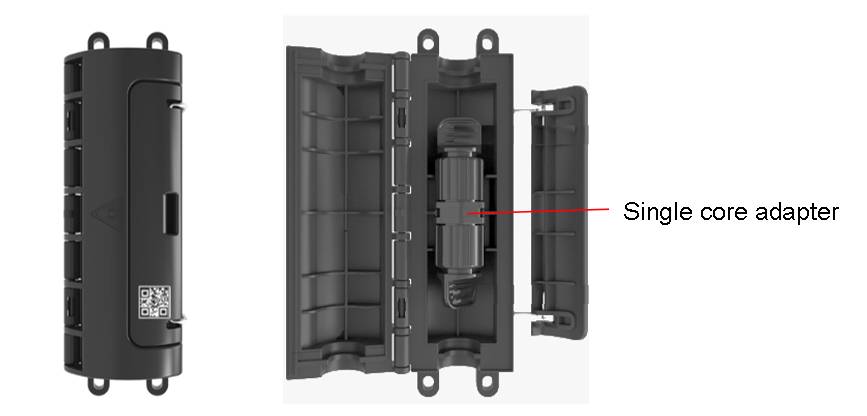
Pre-connection technology is mainly suitable for the introduction section and home section of ODN. The main section and distribution section are not suitable for pre-connection method due to the relatively large number of optical cable cores. There are also manufacturers that provide 12-core pre-connected cable user wiring sections. For more information, please contact us.
Pre-connection technology improves the efficiency of construction and installation and maintenance, and reduces movable connection failures. However, pre-connection technology also has many shortcomings. For example, the attenuation of movable connections will be double or more, and the segment length specifications of pre-connected cable are also difficult to match with the real scene. Therefore, the applicable scenarios of pre-connection technology need to be further explored.

Sorry that there’s no information that interests you. Please fill in the feedback form so that we can improve.